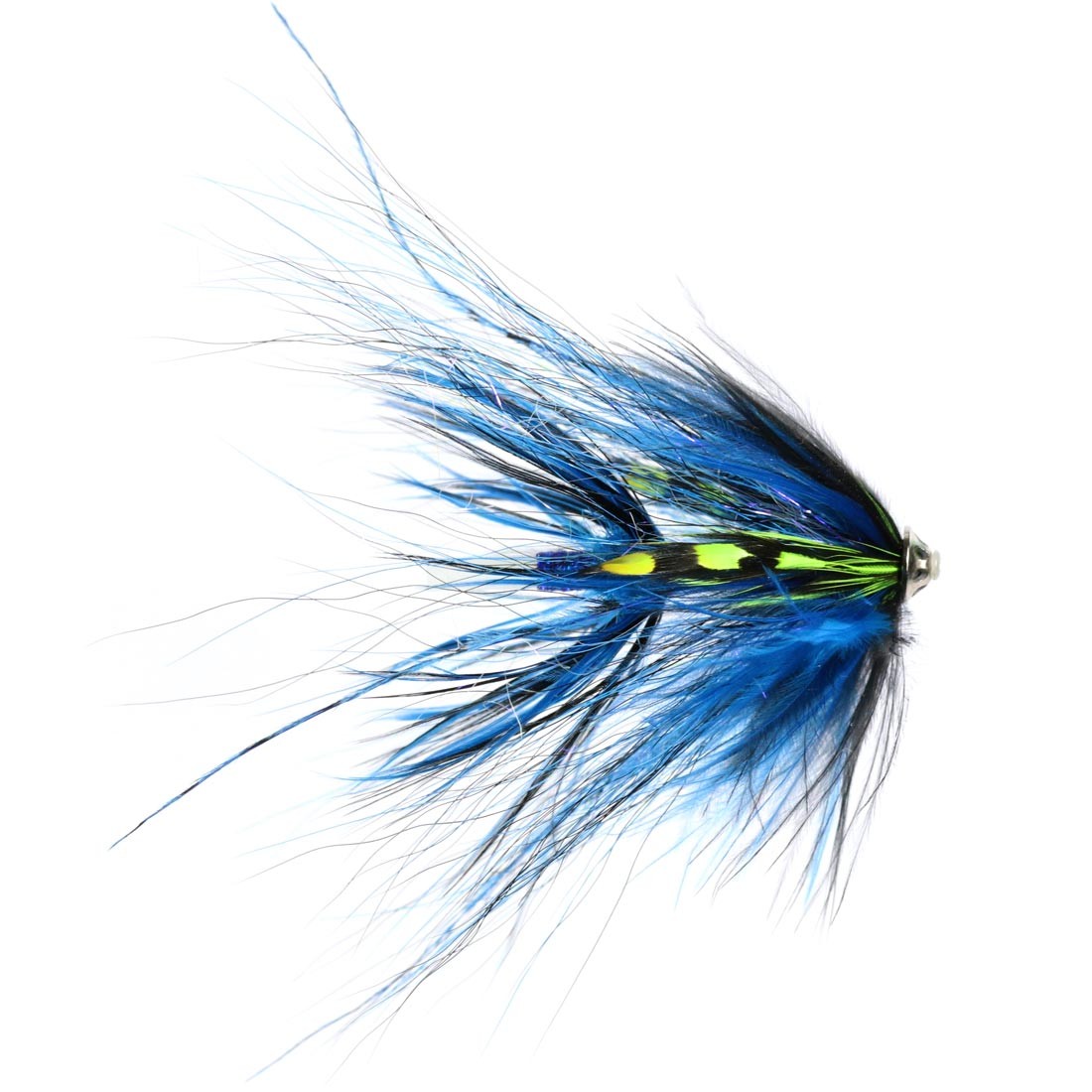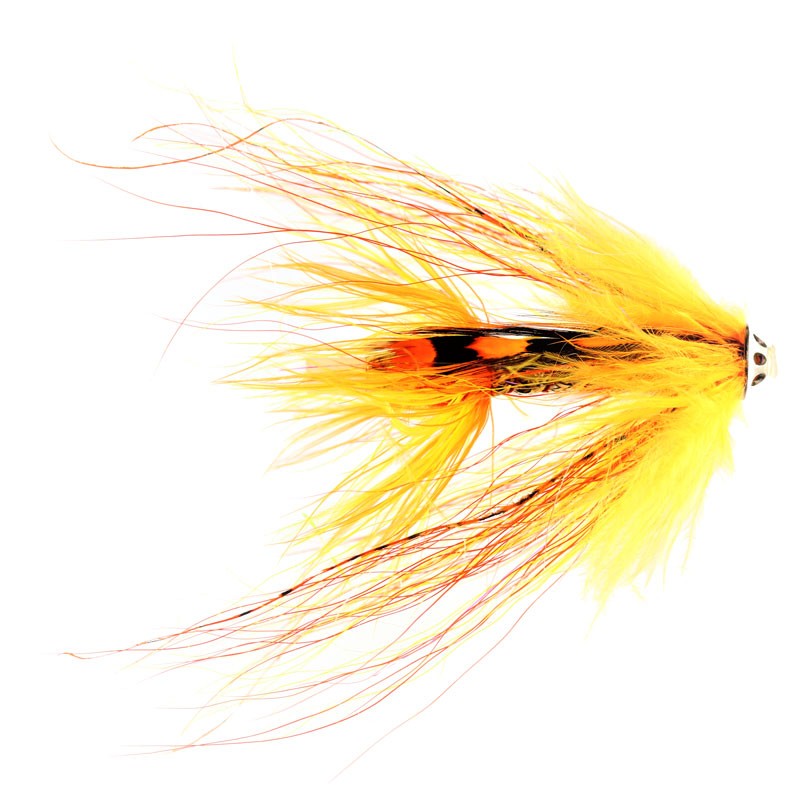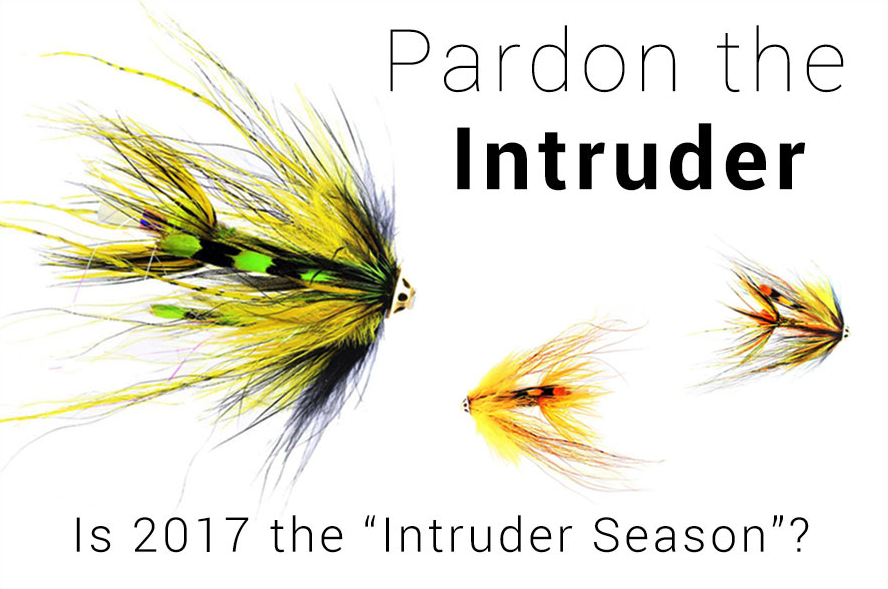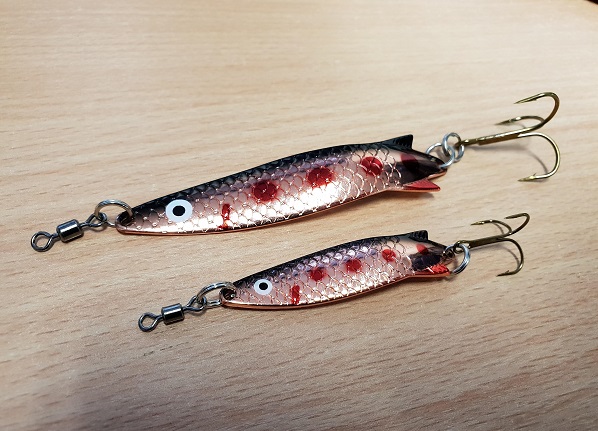- GOLDEN GUNN INTRUDER
- CASCADE INTRUDER
- POSH INTRUDER
- BABA YAGA INTRUDER
Am I Intruding?
The rapid growth of Intruder flies in the UK makes this season:
“The Intruder Season”
This is a particularly hot topic at the moment in UK fly fishing and whether you like them or not, they are here to stay and only becoming more and more popular.
The intruder fly (from the UK perspective) is predominantly a large salmon or seatrout pattern tied on a shank similar to a waddington with a wire traced trailing hook and more recently tied on tubes. The method and materials used are a dubbing-stop or chenille to splay the hackles; a hair constructed hackle of bucktail; and for a long wing usually ostrich, rhea, amherst and marabou. Traditionally dumbbell eyes were mounted on the front of the shank, but most of our UK alternatives are mounted with cones, turbos or a simple varnish.
The intruder pattern is not new; it has been around for over 20 years, but for some reason the UK is just getting interested in them now except for a few guys that have been “in the know” for years. I have to say this is quite typical of the UK’s tackle trade however. This is repeated over and over again ie. switch rods, scandi heads, and even still to this day, most trout anglers are still buying 10ft #7 fly rods when the rest of the globe uses 9ft #5 even for the big browns of New Zealand and Patagonia. We might be slower in taking on the new ideas, however, when the UK likes something in the fishing tackle trade, it really likes it, and the emergence of the intruders are here.
In my eyes intruders have gone two ways, one which is the original style, weighted and fished deep or in fast columns of water with skagit lines and tungsten tips, AND, they have also gone super-lightweight on plastic or aluminium tubes that are easy to cast with your trusty shooting head. Both have their place and both are proven in our rivers.

BABA YAGA INTRUDER
Benefits:
So now you can cast a large profiled fly with a fantastic teasing movement further than before because of a sparse amount of materials tied in a way that gives the fly body but not water retention that hinders the line’s performance. Also, a better placed single hook at the tip of the tail, lighter and off-centre seems to rarely fail when setting a take. These flies arguably allow the angler to strike too, a knee-jerk reaction that has been drummed out of traditional Spey anglers since the dawn of time. The fact that the hook is the last thing hanging out the back of the fly means that any take should potentially hold, unlike double and treble hooks half way up the fly. The strike can be so addictive and powerful, and you know what you’re into immediately.
- DAIICHI INTRUDER TRAILER HOOKS
- PARTRIDGE PATRIOT STINGER HOOKS
History:
You can find out the comprehensive history of intruders on many sites but in brief they are supposed to have been invented by the one and only Ed Ward… “Who?” you ask… Prior to the Millennium, Ward apparently designed the intruder to target the varied salmon of Alaska. The rivers are fast and deep and getting down to the fish is difficult without a heavy fly. Long shanked hooks were cut at the bend and dressed and a stinger hook attached to the end, the rest is history. The success of the full bodied, yet sparsely tied fly boasting superb movement and great hook up success, that was also easier than more conventional flies to cast, caught the attention of steelhead anglers too across the land. These anglers included the huge names in the US fly fishing world of Jerry French, Dec Hogan and Scott Howell. Ward developed the fly with these fledgling super-star anglers and guides from a fly that was a concept to a provender-like masterpiece. The intruder now takes priority in any steelhead or chinook anglers fly box, no question. The colours went from subdued and natural to everything from purples, to reds to fluorescent pink & orange sometimes all on the same fly. The brighter the fly, the more aggressive the fishing seemed to be.

GOLDEN GUNN INTRUDER
So they’re here to stay:
I believe the recent shift to intruder style flies in UK waters has come from 2 main areas. The first and smallest is the ever growing accessibility to destination fisheries. UK anglers are flying far afield every year to sample the sport of distant freshwaters in search of a rendezvous with a silver tourist. The “tug is a drug” that can’t be left unattended by most salmon and seatrout anglers regardless of cost, family and work. So, when the UK Winter comes around, the Kings of Chile, or the Steelhead of BC beckon the adventure tourist and their pals looking to swing some feathers. The feathery temptations that work on these destination fisheries have been brought home to our waters, used, tweaked to suit, maybe even bastardised into traditional UK pattern colourations. Innovative fly tyers and now commercial fly suppliers have been getting excited to the point that we are at now coming into 2017, Intruder Season.

The second reason for the shift into intruders is the organic path taken by those anglers who are now quite familiar with the skagit system ie. Shooting line, Skagit line and MOW tips. The Skagit line is now eternally set as one of three types of double handed lines for UK salmon anglers (Spey, Scandi/Shooting Head and Skagit) being the diesel-power delivery system of heavy tips and flies. Having this now established type of line take up prime space on our shelves made anglers enquire as to what flies work best with this style of fly fishing, the intruder quickly became the fascination of many because it gets to places only 2-3 inch copper tubes used get to, but easier and with even more possibilities if on a skagit system.

POSH INTRUDER
- RIO GRIPSHOOTER SHOOTING LINE
- GAELFORCE EQUALIZER SKAGIT PATRIOT
- RIO SKAGIT MOW TIPS
Did you know?
Both Jerry French and Ed Ward who developed the intruder fly, mentioned above, were also the developers of Skagit style lines and casting, so these are two names to remember right? Well get this, the supposed inventor of the intruder, Ed Ward, and designer of skagit style lines and casting, is also one of three designers and the letters in the word now dominating the Skagit tip world from Rio in the acronym “MOW”. Along-side Mike McCune and Scott O’Donnel the three designers chopped up lines until they perfected the perfect short tip to compliment a skagit style line, the Mow tip. So, if you Salmon anglers pelting out skagit style lines and intruders thought you didn’t know Ed Ward, there’s three reasons for you to remember his name and maybe thank him and his buddies under your breath the next time you hook a locomotive in the cold Spring water.

CASCADE INTRUDER
Pardon the “Intusion”:
So to the point of this post from your friendly tackle store – we were easily convinced, in fact I think we begged our excellent supplier of flies, the Caledonia Fly Company, to send stock of the three new intruder patterns that are perfectly suited to our UK waters in proven colours. Tied on tubes to give you the angler flexibility of hook choice and importantly something familiar to have faith in, these stunning flies will tempt anglers and fish alike for the 2017 season and beyond. Welcome to the “Intruder Season”
The Caledonia Fly Company Intruders
- GOLDEN GUNN INTRUDER
- CASCADE INTRUDER
- POSH INTRUDER
- BABA YAGA INTRUDER
Tie them yourself:
If you are a fly tyer and think you’d like to give intruders a go for UK waters, there are people out there all over Facebook that are just nailing the art of tying them.
- ANGLING ACTIVE AMHERST PHEASANT CENTRE TAIL FEATHER
- VENIARD BARRED LONG OSTRICH PLUME
- DAIICHI INTRUDER TRAILER HOOKS
- FUNKY FLY DAZL DUMBBELLS
- FISH SKULL SENYO MICRO SHANKS
- FISH SKULL SENYOS ARTICULATED SHANKS
- FRANC N SNAELDA FEELERS
- FRANC N SNAELDA SMALL INTRUDER HACKLES
- FROZEN NORTH FLY FISHING MARABOU
- GRIZZLY BARRED RUBBER LEGS MEDIUM
- HARELINE DOUBLE PUPIL LEAD EYES
- VENIARD OSTRICH HERLS
- PARTRIDGE PATRIOT STINGER HOOKS
- FUNKY FLY REAL EYE DUMBBELLS
- VENIARD TURKEY MARABOU
- VENIARD STRUNG TURKEY MARABOU BLOODS
- VENIARD WADDINGTON SHANKS
- HARELINE PLAIN LEAD EYES
- FROZEN NORTH FLY FISHING STANDARD 15MM FRITZ
- FROZEN NORTH FLY FISHING 6MM MICRO JELLY
- FRANC N SNAELDA RHEA CENTRE SECTION FEATHER
- MYLAR PIPING
- HARELINE RAINBOW SHIMMER LEGS
- FRANC N SNAELDA SEAN STANTON SIGNATURE CHENILLE
- METZ HATCHERY SOFT HACKLE
- HARELINE SENYOS BARRED PREDATOR WRAP
- HARELINE GRIZZLY BARRED FLASHABOU
- LOOP RUBBER LEGS
- HARELINE SENYOS INTRUDER TRAILER HOOK WIRE
- HARELINE OPST BLACK BARRED OSTRICH











































